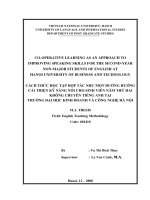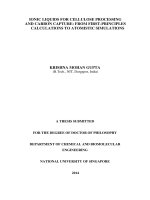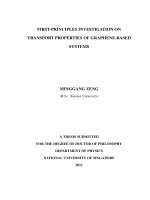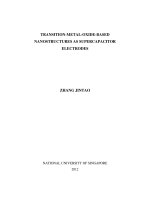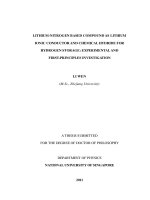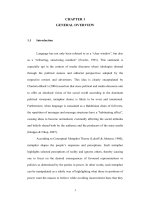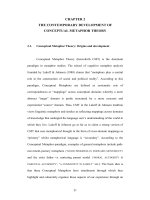Lithium nitrogen based compound as lithium ionic conductor and chemical hydride for hydrogen storage experimental and first principles investigation
Bạn đang xem bản rút gọn của tài liệu. Xem và tải ngay bản đầy đủ của tài liệu tại đây (10.1 MB, 185 trang )
LITHIUM-NITROGEN BASED COMPOUND AS LITHIUM
IONIC CONDUCTOR AND CHEMICAL HYDRIDE FOR
HYDROGEN STORAGE: EXPERIMENTAL AND
FIRST-PRINCIPLES INVESTIGATION
LI WEN
(M.Sc., Zhejiang University)
A THESIS SUBMITTED
FOR THE DEGREE OF DOCTOR OF PHILOSOPHY
DEPARTMENT OF PHYSICS
NATIONAL UNIVERSITY OF SINGAPORE
2011
To the cat
ACKNOWLEDGEMENTS
I-1
ACKNOWLEDGEMENTS
First of all, I would like to thank my supervisor Prof. Ping CHEN accepting me to join her
group. She devotes great patience to guide me to step into the area of hydrogen storage and
chemistry, and always inspires me to observe the world of chemistry by the eyes of physics.
She creates lots of favorable conditions and opportunities for my learning and research. She
possesses magical powers to “push” me to work hard without saying any hard words. Her
kindness and generousness are tranquilizer and sedative for me to get through the tough time
during the research. Her elegant smile is the killer of the restless worm in my belly when I
made “mistakes”… She sets a prefect pattern of being a female scientist in the academic
circles. I would also like to thank my co-supervisor Prof. Yuan Ping FENG, who plays an
essentia l role for my transition from the experimental study to computational study. He
always gives me feedback time ly with valuable comments and suggestions when I met
academic problems, which keeps me moving on the right track. Without his encouragement
and tolerance, my research career might be cut off due to my “malfunction”. My two
supervisors, they certainly deserve the highest marks as research supervisors.
Secondly, I would like to thank Associate Prof. Guotao WU, who is my “agent” to
National University of Singapore (NUS) from Zhejiang University, and my direct reference to
ionic conductivity. He may be not good at teaching by talking, but his profound knowledge
always teaches me in a soundless way. He may be not a quick respondent, but the response
from him could be the golden key to open the door of fact. He may be not a skilled
experiment-operator, but he is a modest idea-integrator. Also thanks Prof. Zhitao XIONG,
who builds our lab in very effective and committed way with a pair of fat and unusually
skillful hands, and I gradually understand and appreciate his unique “Xiong’s style” to guide
the students. I am also grateful to the other members in complex hydride group (1901) in
Dalian Institute of Chemical Physics (DICP) to share their ideas and knowledge with me.
My gratitude also extends to the physicists in the condensed matter theory group in
ACKNOWLEDGEMENTS
I-2
Uppsala University. Prof. Rejeev AHUJA, the leader of group, who kindly supported me to
visit his group in autumn of 2008 to learn computational techniques and provided me a
comfortable accommodation near Uppsala Cathedral. It is not over acclaimed to say that I
profit more from three-month with his group’s members than from three-year of reading,
which made me have a smooth and pleasant transition from experiment to computation at that
time. It is still impressive that when I came to Dr. C. Moysés ARAUJO with my simple even
silly questions on calculations, and he was always kind to response and never tired of writing
the ideas carefully and accurately on paper, which encouraged me to form a good habit of
thinking and solving problems. Muito obrigad! 100+ academic emails from Dr. Ralph H.
SCHEICHER are more concrete evidences than any compliments to describe his immense
enthusiasm and selfless dedication on our later cooperation, which promoted me working with
steady increase of energy and decrease of entropy. Vielen Dank! As an expert of molecular
dynamics simulation, Dr. Ande n BLOMQVIST developed his own code for data analysis,
and shared with me unreservedly. Tackar så mycket! Another special person in Rejeev’s group
is Dr. Duck Young KIM, who kindly guided me to museums in Sweden and Mahler concert;
more importantly, he told me the story of Phonon, which paved a way for my later calculation
on Phonon. 감사합니다! All in all, our productive and harmonic cooperation relationship is
inseparable from their patient guidance, kind encouragement and valuable suggestion in last
three years.
Special thanks to special friends, my old college classmates, Dr. Weili ZHONG and Ms.
Ran WEI. They evoke resonance in me by sharing their spirits and experiences as female
researchers in the scientific society.
I feel glad/lucky to be a chance product of My Parents. They know little about hydrogen
energy is developed due to energy shortage, but they know well about recycling in their
ordinary life. They have no idea about first-principles calculation, but they plant the idea of
taking healthy body and mind as my first-principles. They contribute nothing to the content of
this thesis, but they indirectly “control” the way of my starting, running and ending of this
thesis.
Lastly, the financial support from NUS is gratefully acknowledged.
TABLE OF CONTENTS
II-1
TABLE OF CONTENTS
Acknowledgements I
Table of Contents II
Abstract III
List of Publications IV
Part I
Background Topics
1 Introduction 1
1.1 Overview 2
1.2 Hydrogen Storage Materials 3
1.2.1 Hydrogen properties
1.2.2 Hydrogen storage
1.2.3 Hydrogen storage in pure form
1.2.4 Hydrogen storage via materials
1.2.5 Thermodynamics of dehydrogenation
1.2.6 Literature review
1.3 Lithium Ionic Conductors 12
1.3.1 General aspects of ionic conductor
1.3.2 Possible diffusion mechanism in crystalline ionic conductor
1.3.3 Conduction theory in crystalline ionic conductor
1.3.4 Literature review
1.4 Objective 22
References
2 Experimental Methods 27
2.1 Direct Current (DC) Conductivity Measurement 28
2.2 Alternating Current (AC) Impedance Spectroscopy 29
2.3 Equivalent Electric Circuit and Impedance Spectroscopy Spectra 30
2.4 Differentiation of Ionic and Electronic Conductivity 32
References
TABLE OF CONTENTS
II-2
3 Computational Methods 35
3.1 Introduction 36
3.2 Overview of Density Functional Theory (DFT) 36
3.2.1 The many-body problem
3.2.2 Hohenberg-Kohn theorems
3.2.3 Kohn-Sham equation
3.2.4 Approximations for exchange-correlation functional
3.3 Implementation of the Functional by VASP Code 39
3.3.1 What is VASP
3.3.2 Plane-wave basis sets
3.3.3 Potentials and pseudopotentials
3.3.4 Projector-augmented waves (PAW)
3.3.5 Minimization of the Kohn-Sham energy functional
3.3.6 Relaxation of the ionic system
3.4 Phonon Calculations 43
3.4.1 Introduction of phonons
3.4.2 The direct method
3.4.3 Thermodynamics
3.5 Computational Techniques for the Study of Diffusion and Conduction 45
3.5.1 Defect formation energy
3.5.2 Migration energy: nudged elastic band (NEB) method
References
Part II
Lithium-Nitrogen Based Compound as Lithium Ionic Conductor
4 Similar Li
+
Superionic Conductivity But Distinct Li Diffusion Mechanism in α-Li
3
N
and β-Li
3
N 51
4.1 Introduction
4.2 Experimental Details
4.3 Computational Details
4.4 Results and Discussion
4.4.1 Structure and morphology
4.2.1 Conductivity measurement and diffusion barrier
4.2.2 Lithium removal energy
4.2.3 Li
+
Ions migration energy barriers
4.3 Summary
References
TABLE OF CONTENTS
II-3
5 Li Defect Formation and Diffusion in the Hydrogenation Products of Li
3
N: Li
2
NH
and LiNH
2
65
5.1 Introduction
5.2 Experimental Details
5.3 Computational Details
5.4 Results and discussion
5.4.1 Experimental measurements of conductivity
5.4.2 Microscopic view of ionic conductivity
5.4.3 Native point defects
5.4.4 Frenkel defect formation and diffusion in Li
2
NH
5.4.5 Charged defect formation and diffusion in Li
2
NH
5.4.6 Comparison with experimental results
5.4.7 Defect formation and diffusion in LiNH
2
5.5 Summary
References
6 Mixed-Cation Effect on Li Ionic Diffusion in Ternary Imides: Li
2
Ca(NH)
2
and
Li
2
Mg(NH)
2
87
6.1 Introduction
6.2 Experimental Details
6.3 Computational Details
6.4 Results and Discussions
6.4.1 Experimental measurements of conductivity
6.4.2 Defect formation energy and diffusion in Li
2
Mg(NH)
2
6.4.3 Defect formation energy and diffusion in Li
2
Ca(NH)
2
6.5 Summary
References
Part III
Chemical Hydride for Hydrogen Storage
7 Why LiNH
2
BH
3
∙NH
3
BH
3
Shows Improved Dehydrogenation over LiNH
2
BH
3
and
NH
3
BH
3
101
7.1 Introduction
7.2 Computational details
7.3 Results and Discussion
7.3.1 Electronic density of states (DOS)
7.3.2 Charge density and electron localization function (ELF)
7.3.3 Chemical bond lengths
TABLE OF CONTENTS
II-4
7.3.4 Hydrogen removal energies
7.3.5 Dehydrogenation mechanism of LiAB∙AB
7.4 Summary
References
8 Role of NH
3
Molecule in Ca(NH
2
BH
3
)
2
·2NH
3
and Mg(NH
2
BH
3
)
2
·NH
3
for Hydrogen
Storage 113
8.1 Introduction
8.2 Computational Details
8.3 Results and Discussion
8.3.1 Geometry
8.3.2 Electronic density of states
8.3.3 Phonon density of states
8.3.4 Chemical bond lengths
8.3.5 Hydrogen removal energy and the first-step dehydrogenation
8.3.6 Hydrogen diffusion in solid CaAB, CaAB·2NH
3
and MgAB·NH
3
8.3.7 Deammoniation of CaAB·2NH
3
and MgAB·NH
3
9.3 Summary
References
9 Li-Na Ternary Amidoborane for Hydrogen Storage 137
9.1 Introduction
9.2 Experimental Details
9.3 Computational Details
9.4 Results and Discussion
9.4.1 Synthesis of Li-Na ternary amidoborane by mixing LiAB and NaAB
9.4.2 Special quasirandom structure (SQS) of Li
1-x
Na
x
AB
9.4.3 Thermodynamically favored phase of Li
1-x
Na
x
AB
9.4.4 Electronic and phonon density of states (DOS)
9.4.5 Hydrogen atom removal energy
9.4.6 The first-step dehydrogenation mechanism in the solid NaLi(AB)
2
9.5 Summary
References
10 Conclusions 157
10.1 Materials Modeling Method
10.1.1 Understanding microscopic kinetics of diffusion
10.1.2 Understanding dehydrogenation mechanism
10.1.3 Quantitatively demonstration of thermodynamics of hydrogen storage
TABLE OF CONTENTS
II-5
reactions
10.1.4 Prediction of novel solid-state material
10.2 Li-N Based Materials as Lithium Ionic Conductor
10.3 Metal-B-N Based Chemical Hydrides for Hydrogen Storage
10.4 Prospects
References
Index
ABSTRACT
III-1
ABSTRACT
The development of solid-state materials with superionic conductivities is critical to
solid-state battery technologies. Due to the relatively smaller ionic radius, Li
+
ion
(0.60 Å) is a common conducting species in ionic conductors. Lithium nitride (Li
3
N)
attracts particular attention as a lithium solid electrolyte in the last century because of
its superior ionic conductivity at room temperature. More recently, Li
3
N has been a
focus again since the discovery of Li
3
N-Li
2
NH-LiNH
2
(Li-N-H) system for hydrogen
storage. Li-Mg-N-H and Li-Ca-N-H systems were further developed to improve the
Li-N-H system. In this thesis, both experimental ionic conductivity measurements and
first-principles calculations are employed to investigate the Li
+
ionic conduction
properties and diffusion mechanisms in above systems, i.e., Li
3
N (both α and β
phases), Li
2
NH and LiNH
2
, Li
2
Mg(NH
2
)
2
and Li
2
Ca(NH
2
)
2.
The experimental results
show that Li
+
ions present superionic conduction in the order of ~ 10
–4
S·cm
–1
for
Li
3
N (both α and β phases) and Li
2
NH at ambient temperature; Li
2
Ca(NH
2
)
2
exhibits
moderate Li
+
ionic conductivity of ~ 10
–6
S·cm
–1
; while LiNH
2
and Li
2
Mg(NH
2
)
2
are
almost insulators. The first-principles simulations reveal that α-Li
3
N and β-Li
3
N have
distinct Li
+
ion diffusion mechanisms. In Li
2
NH, the Li
+
ion diffusion is more likely
to occur via interstitialcy mechanism or vacancy-mediated jumps between octahedral
and tetrahedral sites. In LiNH
2
, however, Li defects are difficult to be created to
mediate Li
+
ion diffusion, leading to low concentration of charge carriers and poor Li
+
ion conduction at lower temperatures. Although the involvement of Mg/Ca cations
creates favorable conditions for hydrogen storage, Li
+
conduction could be blocked by
Mg cations in Li
2
Mg(NH
2
)
2
or unfixed N-H bonds orientation in Li
2
Ca(NH
2
)
2
,
resulting in relatively poor Li
+
conduction properties compared to Li
2
NH. These
studies contribute to the understanding of the role of Li
+
ion transport in the
hydrogenation/dehydrogenation pathways of Li-based metal-N-H complex hydrides
ABSTRACT
III-2
for hydrogen storage. More importantly, it promotes the development of complex
hydrides as novel solid lithium ion conductors for battery applications.
In addition to store hydrogen in above Li-N based compounds, another option is
to bond hydrogen with both B and N in chemical hydrides. The representative is
ammonia borane (NH
3
BH
3
, AB), which has attracted considerable attention because
of its high hydrogen storage capacity (19.6 wt. %); however, the relatively poor
kinetics and issues with energetically undesirable regeneration of used fuel are still
big challenges for the practical application of AB. To improve the performance of AB,
a series of derivatives have recently been developed such as metal amidoboranes
(LiAB, NaAB, CaAB), metal amidoborane-ammonia borane (LiAB∙AB), metal
amidoborane ammoniates (CaAB·2NH
3
, MgAB·NH
3
) and multi-cation amidoborane
(LiNaAB). In this study, in-depth theoretical investigations have been carried out to
understand the improved dehydrogenation properties of these chemical hydrides for
hydrogen storage. Furthermore, the first-step dehydrogenation mechanism is proposed
for each system on the basis of solid-phase simulations. The findings stimulate the
attempts to look for new hydrogen storage materials with optimized thermodynamics
and kinetics; moreover, the conclusion could also provide instructive guidelines for
the experimental synthesis and processing of multi-component chemistry hydrides for
hydrogen storage.
LIST OF PUBLICATIONS
IV-1
LIST OF PUBLICATIONS
1. Li
+
Ion Conductivity and Diffusion Mechanism in α-Li
3
N and β-Li
3
N
We n Li
, Guotao Wu, C. Moysés Araújo, Ralph H. Scheicher, Andreas Blomqvist, Rajeev
Ahuja, Zhitao Xiong, Yuan Ping Feng and Ping Chen
Energy & Environmental Science, 2010, 3, 1524-1530
2. Understanding from First Principles why LiNH
2
BH
3
·NH
3
BH
3
Shows Improved
Dehydrogenation over LiNH
2
BH
3
and NH
3
BH
3
We n Li
, Ralph H. Scheicher, C. Moysés Araújo, Guotao Wu, Andreas Blomqvist, Chenzhang
Wu, Rajeev Ahuja, Yuan Ping Feng and Ping Chen
Journal of Physical Chemistry C, 2010, 114, 19089-19095
3. Role of NH
3
in the Dehydrogenation of Calcium Amidoborane Ammoniate and
Magnesium Amidoborane Ammoniate: A First-Principles Study
Wen Li
Inorganic Chemistry, 2012, 51, 76-87
, Guotao Wu, Yongshen Chua, Yuan Ping Feng and Ping Chen
4. Li
+
Ionic Conductivities and Diffusion Mechanisms in Li-based Imides and Lithium
Amide
Wen Li
Physical Chemistry Chemical Physics, 2012, 14, 1596-1606
, Guotao Wu, Zhitao Xiong, Yuan Ping Feng and Ping Chen
5. Li-Na Ternary Amidoborane for Hydrogen Storage: Experimental and
First-Principles Study
Wen Li
Dalton Transaction, 2012, In Press (Featured on a Cover of Dalton Transactions)
, Ling Miao, Ralph H. Scheicher, Zhitao Xiong, Guotao Wu, C. Moysés Araújo,
Andreas Blomqvist, Rajeev Ahuja, Yuan Ping Feng, and Ping Chen
6. Alkali promoted Decomposition of Magnesium Amide
Wen Li, Jianhui Wang, Guotao Wu, Ralph H. Scheicher, C. Moysés Araújo, Zhitao Xiong,
Rajeev Ahuja, Yuan Ping Feng, and Ping Chen. In manuscript
LIST OF PUBLICATIONS
IV-2
7. Mechanistic Investigation on the Formation and Dehydrogenation of Calcium
Amidoborane Ammoniate
Yong Shen Chua, Wen Li
ChemSusChem, 2012, Accepted
, Wendy J. Shaw, Guotao Wu, Tom Autrey, Zhitao Xiong, Ming Wah
Wong and Ping Chen
8. Releasing 17.8 wt % H
2
from Lithium Borohydride Ammoniate
Xueli Zheng, Guotao Wu,
We n Li
Energy & Environmental Science, 2011, 4, 3593-3600
, Zhitao Xiong, Teng He, Jianping Guo, Hua Chen.
9. Potassium Modified Mg(NH
2
)
2
/2LiH System for Hydrogen Storage
Jianhui Wang, Tao Liu, Guotao Wu, We n Li
, Yongfeng Liu, C. Moyses Araujo, Ralph H.
Scheicher, Rajeev Ahuja, Zhitao Xiong, Ping Yang, Mingxia Gao, Hongge Pan and Ping Chen
Angewandte Chemie, 2009, 48, 5828-5832,
10. Hydrogen as Promote r and Inhibitor of Superionicity: A Case Study on Li-N-H
Sys te ms
Andreas Blomqvist, C. Moysés Araújo, Ralph H. Scheicher, Pornjuk Srepusharawoot,
We n
Li
, Ping Chen and Rajeev Ahuja
Physical Review B, 2010, 82, 024304-1-024304-5
11. Growth of Crystalline Polyaminoborane through Catalytic Dehydrogenation of
Ammonia Borane on FeB Nanoalloy
Teng He, Junhu Wang, Guotao Wu, Hyunjeong Kim, Thomas Proffen, Anan Wu,
We n Li
, Tao
Liu, Zhitao Xiong, Chengzhang Wu, Hailiang Chu, Jianping Guo, Tom Autrey, Tao Zhang,
Ping Chen
Chemistry - A European Journal, 2010, 16, 12814-12817
PART I Background Topics
1
1
Introduction
This chapter presents the background of the research of this thesis. Section 1.1 provides a
brief overview of the energy crisis and environmental problems in the 21
st
century. Section
1.2 and 1.3 introduce the basic concepts and knowledge to understand hydrogen storage
materials and solid lithium ionic conductor, and literature reviews are summarized for each
topic. Finally, section 1.4 presents the objective of this thesis.
1 Introduction
2
1.1 Overview
All human activities involve consumption of energy. Nonrenewable energy sources such as
oil, natural gas, coal and nuclear energy are supplying 85 % of the world‟s energy
consumptions today. In 2008, the total worldwide energy consumption was 474 exajoules (1
quad Btu = 1.055 exajoules).
1
A human being consumes about 0.9 GJ energy per day,
equivalent to burning 32 kg of coal per day.
2
As the world‟s population continues to grow at
a quarter of a million people per day, the consumption of energy is correspondingly
increased. Besides, these nonrenewable energy sources are expected to be depleted within a
couple of centuries. Therefore we are facing a great crisis in the supply of energy in the near
feature.
Moreover, increased use of fossil fuels also has some negative environmental effects, in
particular the global warming effect.
3
The carbon dioxide level in the earth‟s atmosphere has
increased due to heavy industrialization from the value of 313 ppm in 1960 to 375 ppm
presently, and the average temperature of earth has increased by 0.5 ºC during the same
period. If global warming continues to take place, then a stage might be reached when our
existence will be threatened.
Inevitably, we have to look for alternative and clean sources of energy to supply the
increasing energy demands and to reduce global warming effect in the foreseeable future. It
is widely believed hydrogen will be the energy carrier and become the main fuel to power
most vehicles and portable devices in the next decades, as hydrogen is the most abundant
element in the universe and the combustion of hydrogen leads to water with no harmful
by-products. To achieve the effective use of hydrogen, the storage of hydrogen is a key issue.
Currently the most promising and effective approach is to store hydrogen chemically in the
lattice of solid-state materials.
In addition to the use of hydrogen as a physical media and energy carrier to store
chemical energy, other devices like battery can also be used to store chemical energy. A
battery is composed of several series and/or parallel array of electrochemical cells, which
consist of a positive and a negative electrode, separated by an electrolyte which is capable of
conducting ions between the two electrodes. There have been numerous types of batteries
depending on the energy storage media and mechanism. Among them, lithium ion
rechargeable batteries, widely used in portable electronic devices, currently outperform other
systems because of their high energy density and design flexibility.
4-6
As the key component
of a battery, the choice of electrolyte is crucial for the performance of batteries. Due to their
distinguished properties in terms of safety, cost, self-charge, and stability, solid lithium ion
conductors have attracted considerable interests in the development of lithium ion battery
technology.
7,8
PART I Background Topics
3
In this thesis, solid hydrogen storage material is one of the main topic, and the novel
properties of Li-N based hydrogen storage materials as lithium ion conductors is also
investigated.
1.2 Hydrogen Storage Material
1.2.1 Hydrogen properties
Hydrogen is the simplest atom having an electron accompanied by one proton, thus has the
best ratio of valence electron to proton among all the elements in the periodic table, and the
energy gain per electron is very high. Thus energy storage in the form of hydrogen can be
more effective in comparison to other available energy storage options.
9
Hydrogen is the most abundant element in the universe and makes up about 90% of the
atoms or 75% of the mass of the universe, and accounts for up 1% of earth‟s total mass.
However, hydrogen is not commonly found in the pure form on our planet, while being
extremely reactive, hydrogen forms numerous chemical compounds, such as water, minerals,
and hydrocarbons. Hydrogen can be produced from renewable sources such as electrolysis
of water and reforming ethanol.
Hydrogen combined with oxygen to form water, releasing energy. In the reaction of
H
2
(g) + O
2
(g) → 2H
2
O, the energy content for 1kg of hydrogen is 141,600 kJ, which is
highest combustion energy released per unit of weight of any commonly occurring material
(almost three times as much as gasoline). Moreover, this reaction has no environmental
impact, as no harmful emissions are produced.
Due to the above physical and chemical properties of hydrogen, we can see the
powerful potential of hydrogen to act as the “fuel of future”.
1.2.2 Hydrogen storage
One of the important matters with the effective use of the energy is that the schedule of
energy use is often not synchronous with its acquisition. As an energy carrier, hydrogen
moves energy in a usable form from the place of production to the place of utilization, thus,
storage system is indispensable. To store hydrogen in a safe, efficient, compact and
economic manner, the following requirements should be satisfied:
i) High gravimetric densities (> 5.5 %)
ii) High volumetric densities (> 40 g H
2
/L)
iii) Moderate operation temperature (–40/85 ºC)
iv) Near-ambient operating pressures (0.5/1.2 MPa)
v) Fast kinetics (0.02 g H
2
/s /kW)
1 Introduction
4
vi) Low cost
Several methods have the potential of meeting these requirements. Conventional ways are to
store hydrogen in the pure form, such as compressed gas or as liquid hydrogen. Currently,
great attention has been given to storing hydrogen in three classes of materials, i.e.,
hydrogen adsorbents, reversible metal hydrides and chemical hydrogen storage materials
due to their high-capacity for storage of hydrogen.
10
Those methods will be briefly described
below, with the focus on metal hydrides and chemical hydrogen storage materials.
1.2.3 Hydrogen storage in pure form
1.2.3.1 High pressure gas cylinder
Hydrogen can be stored as a compressed gas under high pressure in a cylinder, with a
volumetric density up to 36 kg/m
3
. This way is broadly used for transportation of a small
amount of gas, and has been done successfully for many years. This traditional method is
simple, reversible; however, the rather low hydrogen density, high cost of the cylinder and
high pressure (most cylinder systems operate at 350 bar or higher) limit its large-scale
application.
1.2.3.2 Liquid hydrogen
Hydrogen can also be stored as a liquid at –253 ºC and under pressures of a few bars in
superinsulated tanks, with a volumetric density of 71 kg/m
3
, which is almost twice as much
as that of high pressure hydrogen. While the large energy consumption for cooling process,
and high cost for tank manufacturing and unavoidable energy loss due to boiling off
hydrogen, liquid form of hydrogen is not preferable for mobile and portable applications.
1.2.4 Hydrogen storage via materials
1.2.4.1 Adsorbents
Hydrogen molecules can be absorbed via physisorption mechanism on the surface of
materials such as carbon-based materials (like carbon nanotube and fullerene modified
materials), metal-organic frameworks (MOFs) and molecular clathrates. The interaction
between molecular hydrogen and the sorbent is dominated by weak Van der Waals bonds,
translating to an adsorption enthalpy of 4~10 kJ/mol, which is too weak to hold the
hydrogen molecules to the surface under these conditions, though the kinetics of hydrogen
absorbing and releasing is fast. Metal-decorated nanostructures have been further developed
to strengthen the interaction between the substrate and hydrogen, and this interaction is
known as the Kubas interaction, the strength of which lies between those of chemisorptions
and physisorption.
11
The Kubas interaction is a three-centre, two-electron mechanism which
PART I Background Topics
5
involves the donation of electronic density from σ-state of hydrogen molecule to an empty
d-state of the metal atom, thereby leading to the metal-dihydrogen complexes and increasing
the binding energy.
12
1.2.4.2 Metal hydrides
Many different elements react with hydrogen forming a wide variety of hydrides. The
interaction between hydrogen and host compounds is a kind of strong chemisorptive binding
of atomic hydrogen. Hydrogen can be stored and released via chemical reactions between
hydrogen and those compounds. In general, the chemical reaction-based hydrogen storage
materials are mainly classified into three groups: metal hydrides, complex hydride and
chemical hydrides.
Some metals and their alloys can react with hydrogen to form metal hydrides, M+ H
2
↔
MH
x
, and hydrogen forms, in general, metallic bond with the host metal atoms. Such
reversible hydriding/dehydriding reactions render metal and their alloys potential hydrogen
storage materials. There are several categories of metal hydrides based on different alloy
types, such as elemental-type (MgH
2
), BCC (body centre cubic) -type alloys (Fe–Ti, Ti–Mo
and V-based), AB
5
alloys (LaNi
5
H
x
), AB
3
alloys (CaNi
3
H
4.4
), and A
2
B alloys (Mg
2
NiH
4
). In
these materials, hydrogen could be inserted in the lattice of metal/alloy with no topological
change of the crystal structure of the metal/alloy (such as PhH, FeH
2
, LaNi
5
H
x
), or with new
structure formed (such as MgH
2
and AlH
3
). Metal hydrides have been intensively
investigated for a few decades, but the generally low gravimetric hydrogen density
(especially for transition metals and their alloys), or relatively too strong or too weak
hydrogen-host bonding makes metal hydrides not recommended for automotive application.
Complex hydrides are ionic hydrogen-containing compounds, in which hydrogen atoms
are covalently bonded to central atoms (such as N, B, Al) to form complex anions, such as
amides ([NH
2
]
–
), borohydrides ([BH
4
]
–
) and alanates ([AlH
4
]
–
), and these complex anions
form ionic bonds with lightweight metal cations (such as Li, Na, Mg or Ca). Many complex
metal hydrides have high hydrogen gravimetric storage capacities. LiBH
4
, as an example,
has theoretical gravimetric and volumetric hydrogen densities of 18.5 wt% H
2
and 120 g
H
2
/L, respectively. In spite of the high hydrogen capacity, most complex hydride systems
present slow kinetics and/or unfavorable thermodynamics when releasing hydrogen; while
extensive studies indicated that the kinetic barrier could be remarkably lowered by the
addition of catalysts such as Ti, Ni and Co,
13
and thermodynamic properties of complex
hydrides can be tuned via compositional alteration. These breakthroughs make complex
hydrides interesting to be further developed for practical application.
1.2.4.3 Chemical hydrogen storage materials
1 Introduction
6
Similar to complex hydride, hydrogen is covalently bonded in chemical hydrides. Typical
chemical hydrides, represented by ammonia borane (NH
3
BH
3
, AB) and its derivatives, have
attracted increasing interests recently, as they possess remarkably high gravimetric and
volumetric capacities. AB, for example, contains over 19 wt % and 150 g H
2
/L of hydrogen
by weight and volume; moreover, the near-ambient operating condition also makes those
chemical hydrides appealing. However, chemical hydrides are normally utilized as
single-use fuels, and the high energy cost for regeneration could limit the practicality of
AB-based materials. Nevertheless, due to the high capacity and moderation operation
condition, it is still worth research efforts to develop new strategies to improve the
performances of the chemical hydrides family to meet with the requirement for the onboard
application. More detailed review of the properties of chemical hydrides, with an emphasis
on AB-based hydrides, will be discussed later.
The general classification of hydrogen storage materials is displayed in Chart 1-1.
Chart 1-1. Classification of hydrogen storage materials
1.2.5 Thermodynamics of dehydrogenation
1.2.5.1 Hydrogen removal energy
PART I Background Topics
7
The process of dehydrogenating chemical-based hydrogen storage materials can be
described as the break-up of the hydrogen-host bond, the dissociation of hydrogen atom and
combination of hydrogen atoms into H
2
. Therefore the kinetics and thermodynamics of
dehydrogenation could be partially reflected by the strengths of hydrogen-host bonds, which
can be quantified by the Hydrogen removal energy. Hydrogen removal energy is defined as
the change in enthalpy before and after the dissociation of hydrogen atom from the system.
14
The hydrogen removal process is specified as
XH
n
→ XH
n-1
+ H
→ XH
n-1
+ 0.5 H
2
(1.1)
in which XH
n
and XH
n-1
denote the solid system containing n hydrogen atoms and the
system with one hydrogen atom removed, respectively, and the removed hydrogen atom is
desorbed to vacuum to associatively form a H
2
molecule. The hydrogen removal energy is
defined accordingly as,
ΔE
H
= E
coh
[XH
n-1
] + 0.5E
coh
[H
2
] – E
coh
[XH
n
] (1.2)
where E
coh
is the cohesive energy, the difference between the electronic total energy of the
atoms of a solid and the sum of the total energy of individual free atoms. Normally the
hydrogen atom within the longest host-H bond was chosen to be removed in each solid
structure.
1.2.5.2 Gibbs free energy of solid hydrides
The Gibbs free energy of a solid-phase is given by
( ) ( ) ( ) ( ) ( )G T H T TS T U T pV TS T
(1.3)
in which H(T), S(T), U(T) refer to enthalpy, entropy and internal energy, respectively, T the
temperature, p the pressure and V the volume. Since the effect of pressure on the free energy
of solid is small, we can neglect the pV term.
15
Therefore, the Gibbs free energy can be
expressed as
elec vib vib elec vib
( ) ( ) ( ) ( ) ( ) + ( )G T U T TS T E H T TS T E G T
(1.4)
where E
elec
is the static electronic energy at T = 0 K obtained from the first-principles
calculation, and the terms H
vib
(T) and S
vib
(T) are the vibrational enthalpy and entropy,
respectively, at finite temperature T.
vib
0
1
( ) ( )( )coth( )
22
B
H T r d g
kT
(1.5)
vib
0
( ) ( ) ( ) coth( ) 1 ln 1 exp( )
22
B
B B B
S T rk d g
k T k T k T
(1.6)
G
vib
(T) is the phonon contribution to the free energy, which can be calculated as a function
of temperature T within the harmonic approximation by
1 Introduction
8
vib
0
( ) ( )ln[2sinh( )]
2
B
B
G T Nk T d g
kT
(1.7)
where N is the number of super cell, k
B
is the Boltzmann constant, and ω is the phonon
frequencies, and g(ω) is phonon density of states obtained by the direct methods, ћ is the
reduced Planck constant.
1.2.5.3 Enthalpy of dehydrogenation
The dehydrogenation enthalpy is defined as the difference in the formation enthalpies
between reactants and products, which can be estimated as follows:
R reactants
products
H H H
(1.8)
where ΔH is the formation enthalpies of the materials involved in the reaction, which can be
calculated with respect to the enthalpy of the neutral phase of each element,
A B C A B C A B C
x y z x y z
H H xH yH zH
(1.9)
where H is enthalpy, which is defined as
( ) ( )H T U T pV
(1.10)
where U(T) is the internal energy, p the pressure, and V the volume. For solid-phase the
effect of pressure on the energy of solids is small, and the pV term can be neglected,
15
thus
0
solid elec vib
( ) ( ) ( )H T U T E H T
(1.11)
For the molecule (such as H
2
, N
2
and NH
3
) in the gas-phase, an additional term should be
added in equation (1.11)
0
mole elec vib mole
( ) ( )+ ( )H T E H T E T
(1.12)
where E
mole
(T) is the contribution from the translational (3/2k
B
T), rotational, as well as the
pV terms (k
B
T) due to the molecular degrees of freedom. In eqs (1.11) and (1.12),
0
elec
E
is
the total electronic energy at T=0 K calculated by the first-principles calculations, and the
term H
vib
(T) is the vibrational enthalpy contribution at finite temperature T, which can be
obtained within the harmonic approximation by
vib
0
B
1
( ) ( )( )coth( )
22
H T r d g
kT
(1.13)
where T is the temperature, r is the number of degrees of freedom, ћ is the reduced Planck
constant, k
B
is the Boltzmann constant, and g(ω) and ω are the phonon density of states and
the frequencies obtained by the direct method.
1.2.6 Literature review
1.2.6.1 Lithium-nitrogen based compounds for hydrogen storage
PART I Background Topics
9
Development of high-capacity hydrogen storage materials is a critical issue in the use of
hydrogen as an energy carrier for fuel cell technologies. In the last ten years, several
promising lithium-based complex hydrides, such as amides,
16-23
alanates,
24-30
borohydrides
31-35
have been intensively investigated since the discovery of Li
3
N-Li
2
NH-LiH hydrogen
storage system
36
. The hydrogenation of lithium nitride (Li
3
N) was preceded by a two-step
process with the formation of lithium imide (Li
2
NH) and lithium amide (LiNH
2
), according to
the reaction (1.14),
Li
3
N + 2H
2
Li
2
NH + LiH + H
2
LiNH
2
+ 2LiH (1.14)
Through the above reaction, 10.5 wt. % of hydrogen can be reversibly taken up under
moderate conditions. The mechanism of reaction (1.14) is still subject of intensive research.
Huq et al.
37
and Weidner et al.
38
identified non-stoichiometric „quasi-imide‟ phases (Li
2+x
NH)
with composition-dependent lattice parameters as the intermediates during the first step
hydrogenation of Li
3
N. In the second step, David et al.
39
found a series of non-stoichiometric
phases (Li
2-y
NH
1+y
) with cubic anti-fluorite (Li
2
NH-like) structure and suggested that the
diffusion of Li
+
cations in the hydrogenation leads to the formation of LiH and H
+
, and then
H
+
combines with [NH]
2–
to generate [NH
2
]
–
. Therefore, the diffusion conditions of small and
mobile species, i.e. Li
+
, may play a crucial role during the kinetic cycling of hydrogenation
and dehydrogenation in Li
3
N, Li
2
NH and LiNH
2
.
Although Li
2
NH/LiNH
2
system are promising, the desorption/absorption temperature
(>250 ºC at 1.0 bar) are still too high for practical use; moreover, it was highly endothermic
with the heat of reaction of 66 kJ/mole H
2
. In order to lower the hydrogen equilibrium
temperature, elemental replacement of Li cation by other metal ions such as Mg was
investigated by several groups.
17,18,23,40-43
By reacting Mg(NH
2
)
2
with LiH or LiNH
2
with
LiH, around 5 wt% H
2
can be reversibly stored in the ternary system at about 180 ºC
(equilibrium hydrogen temperature is ~ 90 ºC) :
2LiNH
2
+ MgH
2
→ Li
2
Mg(NH)
2
+ H
2
←→ Mg(NH
2
)
2
+ 2LiH (1.15)
The experiments also indicated that hydrogenation reaction enthalpies reduce to 44.1kJ/mol
H
2
, which is more favorable for polymer electrolyte membrane (PEM) fuel cell application.
There was an argument on the reaction mechanism proposed for the dehydrogenation of
this system. One is the ammonia-mediated mechanism
44
, in which Mg(NH
2
)
2
first
decomposes to MgNH and NH
3
, and NH
3
further reacts with LiH to produce LiNH
2
and H
2
.
The other is the direct solid-state reaction mechanism,
18,23
in which the strong potential in
combining the positively charged hydrogen H
δ+
in Mg(NH
2
)
2
and negatively charged
hydrogen H
δ–
in LiH into molecular H
2
induces the direct reaction between amide and
hydride. Experimental results showed that the activation energy of the direct solid-state
reaction was ca. 30 % lower than that of ammonia-mediated mechanism.
44
At the initial
stage of the solid-state reaction, interface reaction happens at the interface of amide and

